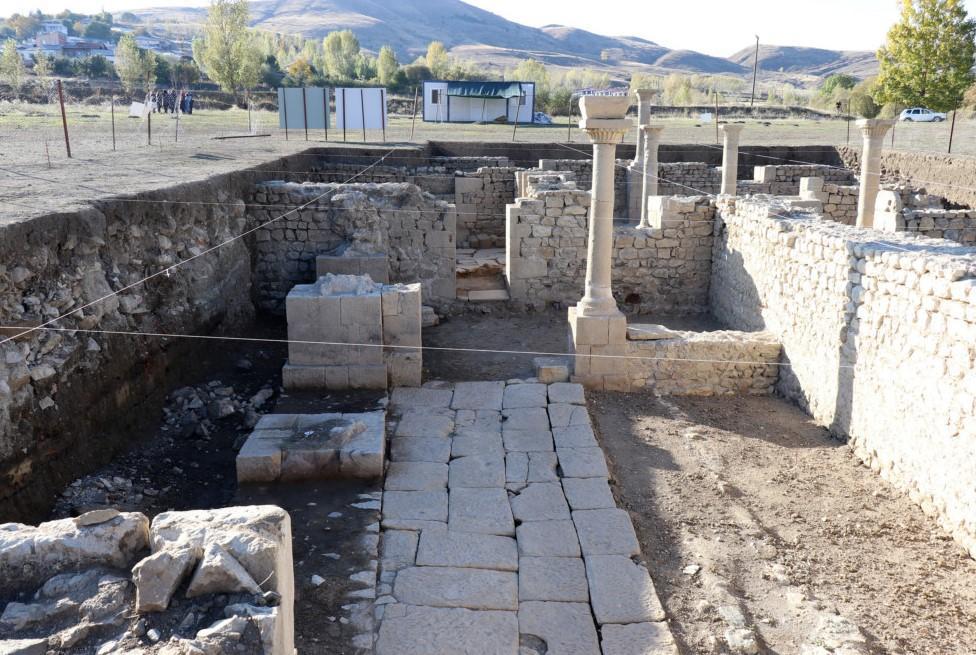
A multi-layered legionary cemetery, carved into the bedrock in the Roman Empire castle, has been unearthed in the ancient city of Satala. A fragment of a 2,000-year-old bronze document called “Diplomata,” which was given to Roman soldiers who completed their 25-year tenure, was also found in a tomb.
In the archaeological excavations carried out in the ancient city of Satala, which is home to the Apollinaris Legion and the 15th Legion Castle and located in the Sadak village of the Kelkit district of the northern province of Gümüşhane, the findings found for the first time in Anatolia have been obtained.
The cemetery of legionnaires, who were the soldiers of the Roman Empire that ruled Anatolia for centuries, has been unearthed for the first time in Anatolia.
Pieces of iron spears and various weapons were also found in the multi-layered cemetery, which have Roman tombs at the bottom and Byzantine tombs at the top.
Anthropological and DNA studies will be carried out on the skeletons in the cemetery to reveal the causes of their injury and death.
Şahin Yıldırım, Director of Bartın University Archeology Application and Research Center, noted that they completed the 2022 excavations in Satala and found a cemetery structure dating to the Roman Imperial period in the last days of their work.
“In the photographs of the past years, the remains of a structure drew attention. We found a necropolis during our excavations around it. For the first time, a cemetery belonging to Roman Legionnaires was unearthed in Anatolia. We found many graves here. Most of these tombs belong to Roman soldiers. We found war equipment such as weapons, spears and arrowheads belonging to these soldiers,” he said.
Noting that they found a person, who was likely a cavalry officer, buried in the main grave in the cemetery, Yıldırım stated that they found a bronze plate, called “Diplomata,” next to this person along with the horse harnesses and terracotta artifacts.
“Diplomata was a document given to Roman Imperial soldiers after completing their military service. We can call it a kind of discharge certificate. The piece of diplomata we found was severely damaged. We could not find its written part but we found its back part. Almost all of the tombs were carved into the bedrock and the skeletons were inside them. A significant part of the finds we found date back to the third century. These are the dates when the Roman Empire lost its former glory and began to weaken. At the same time, this cemetery is a multi-layered cemetery. We have also obtained similar findings dated not only to the Roman period, but also to the Byzantine period and even to the years 607-608, the period when the Sassanids seized this city for the second time. It is not just a single-layer cemetery. It is very important that this diplomata was found here. During the Roman Imperial period, soldiers had to serve 25 years. When this period is over, these documents were given to them,” he said.
Yıldırım stated that for the first time in Anatolia, they obtained important data about both the city walls, the plan type and the structures inside the city walls of a legion castle, and continued:
“So far, not much data has been obtained about the Roman-era castrum structure, which hosted the 15th Apollinaris Legion. Castrums were the main bases and encampments of the legions in the Roman Empire. During the excavations last year, we uncovered some of the walls, but these walls were mostly medieval. However, during our work this year, we found the entrance gate of the castle, which is known to have been built during the reign of Emperor Hadrianus of the Roman Empire. Thus, for the first time in Anatolia, we have obtained important data about both the city walls, the plan type and the structures inside the city walls of a legion castle.”
The archaeological excavations have been ongoing since 2017 in the ancient city of Satala, where the 15th Legion of the Roman Empire, also called the Apollinaris Legion, ruled for about 600 years. The presence of the Urartians in the region has been architecturally proven with historical findings starting 50 centimeters below the ground.
Handmade ceramics and Hellenistic period findings along with the military armor, numerous arrowheads, theater masks, oil lamps, Roman state coins, bricks with the stamp of the 15th legion from the late Roman period were also among the findings in the excavation area.
It was also determined that the legion castle covered an area of approximately 170,000 square meters.